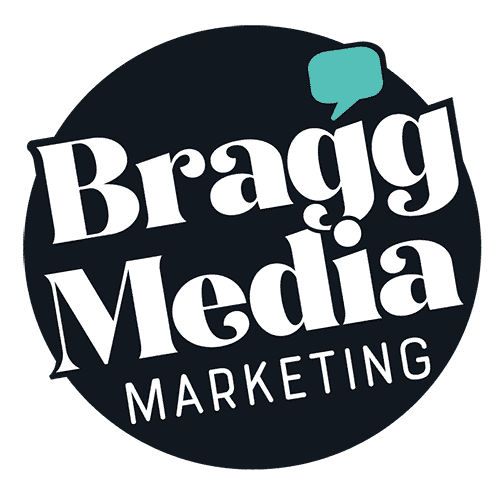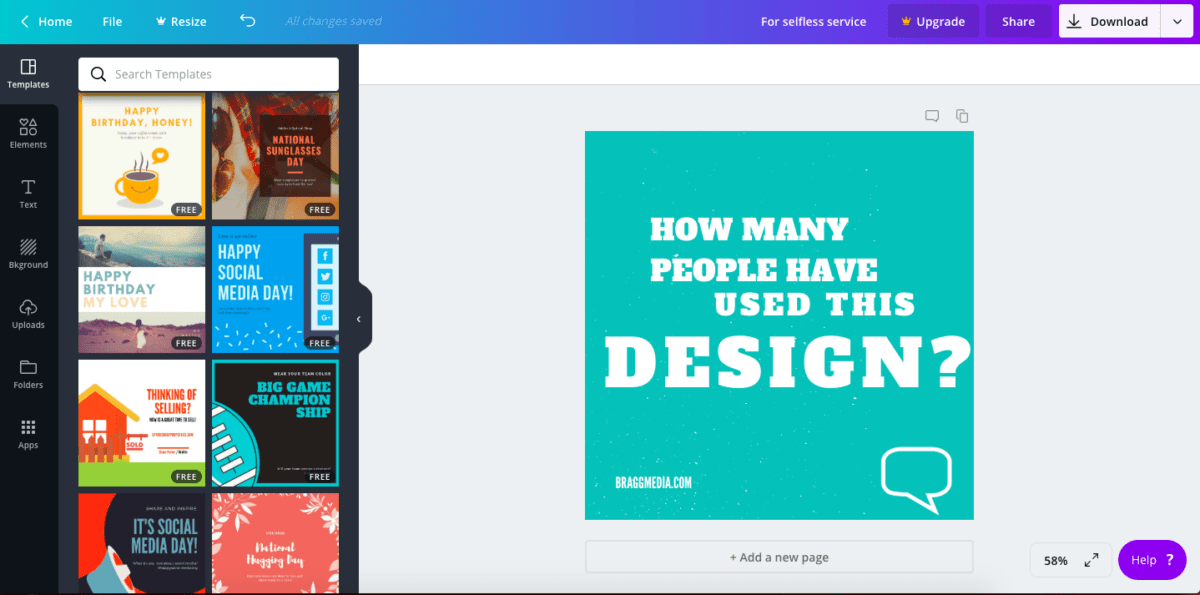The pros and cons of DIY graphic design services
The headline is true.
*Raising hand in air*
Hello. My name is Heather Bragg, owner of a creative marketing agency. I use Canva.
If you aren’t already familiar with Canva, it’s a free do-it-yourself graphic design web and mobile device application. There are a bevy of templates from which you can choose to customize for just about any online and offline marketing endeavor, including Instagram stories, Facebook posts, posters, menus, infographics, etc.
Oh, you know about Canva? You like it, too?
The reason why this article reads like a dirty confessional is because for professional graphic designers, Canva could be a gut punch to the bottom line. Why would anyone need to hire a professional designer if they can do it themselves for free?
I am an Adobe nerd. InDesign, PhotoShop and Illustrator are typically my go-to design applications. I decided to use Canva in part to stay on top of trending technology and and also because professional creatives need to find a way to work with DIY marketing tools. Because they aren’t going anywhere.
Overall, I found Canva fun and easy to use. It felt less like work and more like when I discovered the first version of Windows Paint when I was 9. Like any free marketing tool, however, there are limitations. Here are the pros and cons of Canva that everyone should know.
PRO: Canva saves time
I downloaded the Canva app on my iPhone for a quick on-the-spot social graphic for a client. This particular business had a last-minute event that needed to be promoted on Facebook and Instagram. The ease and intuitive nature of Canva was great! Within less than 10 minutes, I created the graphic, wrote the message and posted it to the Facebook page!
I love the time-saving aspect of Canva for small social media graphics. I created two infographics for Bragg Media’s blog on repurposing content that I also used on LinkedIn and Pinterest. Each social media outlet has different size requirements or aspect ratios, so having an option to quickly choose a template with the correct size is a boon. However, if you want to take the same design for Facebook and automatically resize it for LinkedIn or Twitter, you will have to upgrade to Canva Pro.
Turn your Canva website template into a WordPress website.
CON: Canva has limited free templates and graphics
Canva has a horde of free eye-catching templates that you can completely customize — colors, fonts, graphics, etc. However, there is a limit to the free design templates, and if I exclusively used Canva, this would get old, fast.
Customization also means stock photos and graphics from their depository. However, there is a cap on the number of free graphics and photos from which you can choose. Some of the paid-for templates, graphics and photos are cheesy and generic.
 Graphic Design Packages
Graphic Design Packages
Professional, convenient, flat-rate graphic design
PRO: Canva has an intuitive interface any technological novice can use
I am amazed at how easy it is to navigate and use Canva. If there isn’t something you know how to do, such as add drop shadows to text, Canva has a library of instructional videos or check YouTube for how-to Canva tutorials.
I found Canva especially easy to use, but I have been in front of a computer since Commodore 64 released Hangman on cassette tapes. For those with no graphic design experience or those with no technological prowess, I can’t help but wonder if they would find Canva as easy as I do?
Canva also offers an option to collaborate with a team by sharing the file you’re working on with other people who can work on projects from their mobile devices. Much like professional design programs (such as my beloved Adobe) you can undo mistakes, save project history automatically, easily upload images and choose from a variety of fonts for the sample text to suit your taste. You also can export Canva projects as industry standard .pdf, .png and .jpg files.
CON: Don’t use Canva for large professional design projects
If you need to design a magazine, multi-page booklet or any project with a specific size, don’t use Canva. Projects like this require a more sophisticated technology with options for little details — such as page numbering, ability to edit the shapes of fonts, bleeds and margin settings, CMYK settings for images (needed for professional printing), drop shadow effects, etc.
I love the fun, hip design templates that Canva offers. But I also see these designs used all over the Internet. I have seen two different social accounts use the same design for #MotivationalMonday memes on Instagram, for example. While Canva is an affordable option for budget-conscious businesses, you still need a professional graphic designer for more important projects.
PRO & CON: Canva offers logos
This gets into a sticky conversation about brand identity and brand awareness. Professional designers who work for branding companies and marketing agencies would likely say that Canva is a blight on the creative industry because it generifies (that is a word, according to urban dictionary) the brand design process. It’s like using the Comic Sans font for anything that is supposed to be professional. In the creative industry where professionals view brand identity design as an art form, you don’t do that!
The Canva logos may look great for the first year or two of your business. Their designs are colorful and very modern. However, brand identity design should be timeless — not trendy. Your logo is a visual representation of your business that should stand the test of time. The question that begs to be asked: Would Canva devalue a brand due to its popularity and tendency to lean toward templated design?
Bottom line: I do not recommend using their Canva templates for a logo. If you take the DIY route for logo design, use Canva as a design application not a template maker. Even Canva warns against this:
Canva’s pre-made logo layouts and elements are used by many people, so your logo will not be exclusive to you if you don’t heavily modify the design and elements. Non-exclusive logos cannot be trademarked. If you intend to trademark your logo, use only elements that you’ve created yourself or commissioned directly.
PRO or CON: The Bottom Line
I will likely continue using Canva for small social media memes for Bragg Media and for some other clients as needed. It saves time and they look great. However, because I know a lot of other people use Canva I still spend more time than most customizing the templates so they have a personal touch.
Overall, Canva is a great, affordable option for startups and small businesses that are on tight budgets and aren’t ready for marketing agency retainers.

About this Blogger: Heather Bragg
Before Heather entered the world of marketing, she was a newspaper journalist. Today, she is best known for developing well-rounded marketing plans that focus on the long-term.
Like what you’re reading?
Subscribe to Bragg Media’s
monthly newsletter.

